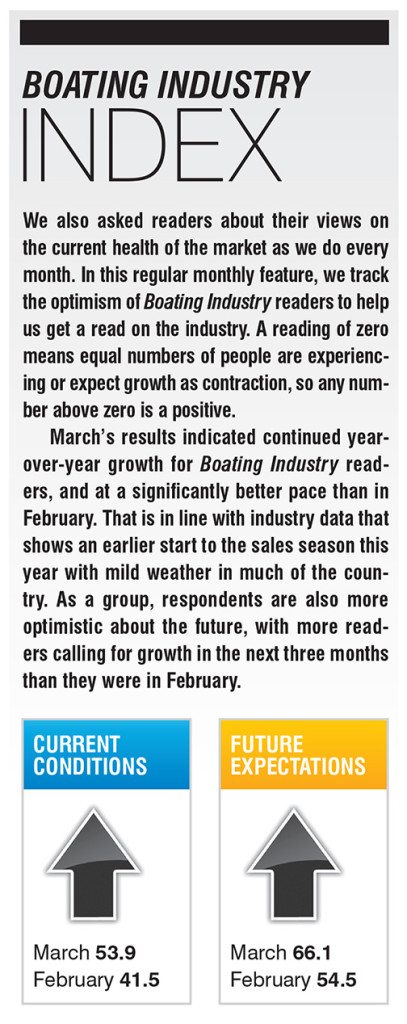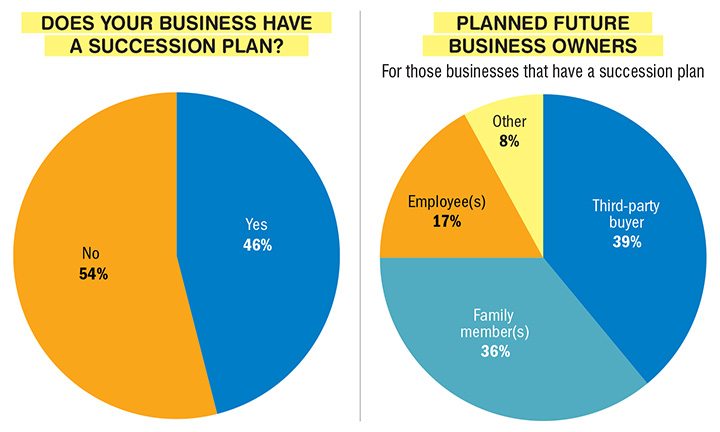Research: Many companies have no plans for exit strategy

Just less than half of marine industry companies have a succession plan or exit strategy for their business.
That’s according to the latest survey of Boating Industry print and digital subscribers, conducted by email in March and April. Respondents were a mix of boat dealers, manufacturers, marina owners and others working in the industry.
While only 46 percent of readers reported having a current plan in place, that puts the industry well ahead of most family-owned small businesses. According to the 2014 Family Business Survey from PwC, only 16 percent of family firms have a succession plan in place. (Read more about planning your exit strategy in our March issue or at BoatingIndustry.com.)
 The succession issue can be especially challenging for family businesses, leading to a high failure rate. According to a 2012 Harvard study, 30 percent of family businesses successfully transition to a second generation. Only 12 percent make it to a third generation and just 3 percent survive to a fourth generation.
The succession issue can be especially challenging for family businesses, leading to a high failure rate. According to a 2012 Harvard study, 30 percent of family businesses successfully transition to a second generation. Only 12 percent make it to a third generation and just 3 percent survive to a fourth generation.
Who will buy?
Many respondents expressed concerns about who the future owners of their business will be, noting the increased cost of doing business and higher property values, especially for waterfront dealerships or marinas. There is also concern about the interest and ability of the next generation or current employees (see sidebar p. 19).
Of those companies that do have an exit strategy, about half are planning to transition the business to a family member or employee – 36 percent to family and 17 percent to one or more employees. Thirty-nine percent plan to sell the business to an outside buyer.
Most business experts say companies should spend at least 10 years in the planning process for a succession.
According to David Spader of Spader Business Management, companies that start out working on a transition at least 10 years in advance have at least an 85 percent chance of still being in business 15 years after the transition. Those that spend just a few years planning have a 10 to 20 percent likelihood of success, Spader added.
In our survey, the majority of companies have a target date for the transition that is at least a couple years out, with only 11 percent planning to change ownership in the next year. About half of companies are planning their sale in the next one to five years. Forty-one percent have a goal of more than five years, with 20 percent aiming for more than 10 years from now for the transition.
Of the companies we surveyed, 79 percent had been through an ownership transition in the last 10 years. Of those companies, 66 percent described the transition as very successful and 23 percent said it was somewhat successful. Only 11 percent said it was “neutral” or unsuccessful.
Those companies that had problems cited issues with keeping good employees and the wrong person being put in charge of the company.
Of those companies that had completed a sale, 48 percent transitioned to family members, 33 percent sold to a third-party buyer and 19 percent had employees take over ownership.
While the horizon for the planned succession for those companies that have a plan was years out for most companies, that wasn’t the case for companies that have had a transition. Fully 85 percent of those companies spent less than five years planning the transition, and 35 percent did it in less than a year. Nine percent worked on it for six to 10 years and 6 percent devoted more than a decade to planning the transition.






